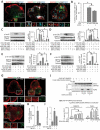Pancreas-specific SNAP23 depletion prevents pancreatitis by attenuating pathological basolateral exocytosis and formation of trypsin-activating autolysosomes
- PMID: 33213278
- PMCID: PMC8526043
- DOI: 10.1080/15548627.2020.1852725
Pancreas-specific SNAP23 depletion prevents pancreatitis by attenuating pathological basolateral exocytosis and formation of trypsin-activating autolysosomes
Abstract
Intrapancreatic trypsin activation by dysregulated macroautophagy/autophagy and pathological exocytosis of zymogen granules (ZGs), along with activation of inhibitor of NFKB/NF-κB kinase (IKK) are necessary early cellular events in pancreatitis. How these three pancreatitis events are linked is unclear. We investigated how SNAP23 orchestrates these events leading to pancreatic acinar injury. SNAP23 depletion was by knockdown (SNAP23-KD) effected by adenovirus-shRNA (Ad-SNAP23-shRNA/mCherry) treatment of rodent and human pancreatic slices and in vivo by infusion into rat pancreatic duct. In vitro pancreatitis induction by supraphysiological cholecystokinin (CCK) or ethanol plus low-dose CCK were used to assess SNAP23-KD effects on exocytosis and autophagy. Pancreatitis stimuli resulted in SNAP23 translocation from its native location at the plasma membrane to autophagosomes, where SNAP23 would bind and regulate STX17 (syntaxin17) SNARE complex-mediated autophagosome-lysosome fusion. This SNAP23 relocation was attributed to IKBKB/IKKβ-mediated SNAP23 phosphorylation at Ser95 Ser120 in rat and Ser120 in human, which was blocked by IKBKB/IKKβ inhibitors, and confirmed by the inability of IKBKB/IKKβ phosphorylation-disabled SNAP23 mutant (Ser95A Ser120A) to bind STX17 SNARE complex. SNAP23-KD impaired the assembly of STX4-driven basolateral exocytotic SNARE complex and STX17-driven SNARE complex, causing respective reduction of basolateral exocytosis of ZGs and autolysosome formation, with consequent reduction in trypsinogen activation in both compartments. Consequently, pancreatic SNAP23-KD rats were protected from caerulein and alcoholic pancreatitis. This study revealed the roles of SNAP23 in mediating pathological basolateral exocytosis and IKBKB/IKKβ's involvement in autolysosome formation, both where trypsinogen activation would occur to cause pancreatitis. SNAP23 is a strong candidate to target for pancreatitis therapy.Abbreviations: AL: autolysosome; AP: acute pancreatitis; AV: autophagic vacuole; CCK: cholecystokinin; IKBKB/IKKβ: inhibitor of nuclear factor kappa B kinase subunit beta; SNAP23: synaptosome associated protein 23; SNARE: soluble NSF (N-ethylmaleimide-sensitive factor) attachment protein receptor; STX: syntaxin; TAP: trypsinogen activation peptide; VAMP: vesicle associated membrane protein; ZG: zymogen granule.
Keywords: Autophagy; IKKβ; SNAREs; caerulein; experimental pancreatitis; pancreatic acinar cell.
Conflict of interest statement
All authors declare no competing financial interests.
Figures






References
-
- Williams JA, Yule DI. Stimulus-secretion coupling in pancreatic acinar cells. In: JL R, editor. Physiology of the gastrointestinal tract. Amsterdam: Elsevier; 2012. p. 1361–1398.
-
- Dolai S, Liang T, Cosen-Binker LI, Lam PL, et al.Regulation of physiologic and pathologic exocytosis in pancreatic acinar cells. The Pancreapedia: Exocrine Pancreas Knowledge Base Available from: https://wwwpancreapediaorg/reviews/regulation-of-physiologic-and-patholo...; DOI: 10.3998/panc.2012.12. - DOI
Publication types
MeSH terms
Substances
Grants and funding
LinkOut - more resources
Full Text Sources
Other Literature Sources
Medical
Molecular Biology Databases
Research Materials
Miscellaneous
